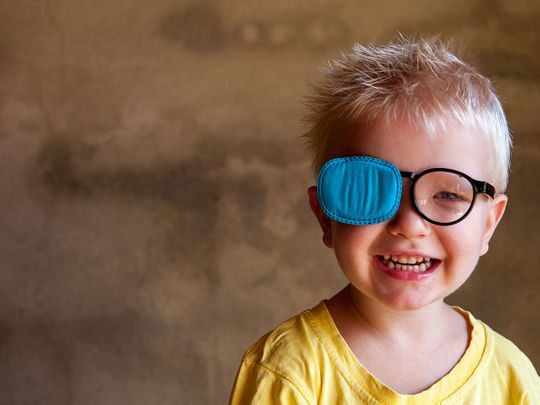
It’s a bit of an acrobatic act each time one looks at something; six muscles act in tandem, the command shooting from one to the next so that the picture is clear. When the muscles don’t line up for any reason, one eyeball may favour one side while the other looks centred. This situation is called a squint.
Before surgery, says 41-year-old Indian expat Rohini (name changed upon request), one of her twins had a squint. “First the doctors suggested we use patches to cover one eye then the other alternatively,” she says. “So, we did the patches for three to six months, but things were still not much better.”
Then came a recommendation from an ophthalmologist that gave her pause. He told her that a small surgery could fix the issue and it would be better if it was done early on. “It will be easier on her if when she starts school everything is normal,” he said.
Dr Saleem Moopen, Specialist Ophthalmology at UAE-based Aster Clinic, explains that early intervention can mean the difference between a short-term tussle and a permanent disability. “Squints in children less than seven years may impair the visual development of the affected eye. Unless treated before the age of seven or eight years, this can become permanent. The fixating eye will see clearly, while the deviating eye will have reduced visual acuity. This is termed amblyopia (lazy eye).”
Rohini was convinced.
Today Rohini applauds her nine-year-old daughter's eyes: “Even she doesn’t remember the squint or the operation,” she laughs. And she is glad for the decision she took.
“I’ve seen many children in the playground, park, and malls – they have squints, some more than others. And from the bottom of my heart, I suggest surgery, because the squint and patch, in their age group, they feel conscious and shy.”
Dr Moopen says early intervention is key. “A true squint will not get better by itself, and early detection and advice on treatment are very important. The size of a squint may reduce with glasses or with treatment to help vision, both of which can make it less noticeable,” he adds.
Glasses: These can help if a squint is caused by a problem with your child's eyesight.
Eye exercises: Exercises for the muscles that control eye movement may sometimes help the eyes work together better.
Surgery: This involves moving the muscles that control eye movement so the eyes line up correctly. It may be recommended if glasses are not fully effective on their own.
Malaysian-expat Stephanie Gregory’s son’s squint was already pronounced when he was born. “One of his eyes was moving towards one side,” says Gregory. “So, we asked the paediatrician, who said that because the nose bridge was flat, and he was so small, there was nothing to worry about. He said that when the nose bridge formed properly it would be fine. We left it for about a year and a half after speaking to a few paediatricians who all said the same thing.”
When he turned two, Gregory’s son was taken to the ophthalmologist who suggested glasses – these were aimed at exercising and strengthening the eye muscles. “After six to nine months he didn’t show any improvement. He didn’t show improvement after patching either. And so, doctors said the only way to go about correcting it would be with surgery. So that’s what we did. The squint improved a lot.”
He still wears glasses, she says, but it’s not for his vision – it helps strengthen the eye muscles. “Refractive errors must be corrected with glass and lazy eye treatment must continue even after surgery,” explains Dr Moopen.
Squint surgery is nearly always a day case procedure so you should be in and out of hospital on the same day.
There are two kinds of squint operation – adjustable and non-adjustable:
Non-adjustable surgery: The operation is usually carried out under general anaesthetic. The operation usually takes up to 60 minutes depending on the number of muscles that need surgery. You’ll need to stay in the hospital for a few hours.
Adjustable surgery: Squint surgery using an adjustable suture may give a better result in certain types of squint e.g. patients who have had a squint operation before, patients with a squint due to injury or patients with thyroid eye problems. The way this works is:
Part 1 – The main operation. The main part of the operation is carried out in the operating theatre usually under general anaesthetic (with you asleep).
Part 2 – Adjusting the stitch. Once you have woken up from the anaesthetic, the final position of the muscles is adjusted when you are awake and able to look at a target. This is particularly useful for treating double vision. If you wear glasses for distance or near, these will need to be brought in with you for this part of the operation. Adjustment is usually done on the ward, after drops of anaesthetic have been put into the eye to take away any pain. You may however feel a pressure sensation.
Source: Moorfields Hospital Dubai
Recovery from a surgery can be a fussy affair. “Sometimes, my daughter would start crying because when she would play with her sister, she wouldn’t be able to properly open her eyes and there was medication to be put ever so often; she was a bit fussy. But this only lasted about a week and then everything was normal,” recalls Rohini.
Gregory calls for parental calm. Her advice to parents who discover a squint is: “Take one day at a time. It’s overwhelming, there’s a lot of information out there and I think a lot of parents feel like they’ve failed if their kid wears glasses and they feel like they might be bullied. Don’t feel that way because the squint also affects the brain and how everything is processed. Do what you need to do.”

A child with a squint may stop processing information from the affected eye, resulting in loss of vision.
Left untreated, warns Dr Anuradha Ajesh, Specialist Paediatrics at Bareen International Hospital, the condition can have a crippling effect on vision. “A child with a squint may stop processing information from the affected eye, resulting in loss of vision.”
Dr Luai T. Eldweik, Associate Staff Physician in the Eye Institute at Cleveland Clinic Abu Dhabi, told Gulf News in an earlier interview: “An untreated lazy eye will eventually impact their binocular vision and significantly reduce their depth perception. This means that they are unable to assess distances, especially in space. So, if a child is playing a sport like football, they will not be able to detect how close the ball is to them, which can cause injuries.”
What can cause a squint?
One of the reasons for a squint is genes, says Dr Moopen. Having family members with strabismus, another name for a squint, can increase a child’s chance of having it themselves. Other reasons are:
- Congenital, or present since birth
- Eye muscle weakness and eye diseases
- Head injury or trauma during an eye surgery
- Sometimes, of course, the exact cause of a squint is not always known.
In children, a squint is often caused by the eye attempting to overcome a vision problem, such as:
- Short-sightedness: Difficulty seeing things that are far away
- Long-sightedness: Difficulty seeing nearby objects
- Astigmatism: Where the front of the eye is unevenly curved, causing blurred vision
Another factor that may be negatively impacting a child’s eye muscles is screen time. “Some studies have found that children who spent more than four hours a day in front of a bright screen are most at risk of myopia and squint eye, especially those who don't take frequent breaks,” explains Dr Moopen.
Try these tips on screen-loving kids, says Dr Eldweik:
Encourage regular breaks. Children should be encouraged to take a break every 30 minutes to walk around, drink water and just move their body.

Children should spend at least one hour outdoors so that they can take advantage of the bright ambient light that helps the eye function. They also get a break from screens and focusing on close objects.
Play time. Children should spend at least one hour outdoors so that they can take advantage of the bright ambient light that helps the eye function. They also get a break from screens and focusing on close objects.
Eye drops and contact lenses. Sometimes, we prescribe eye drops that are proven to slow the progression of myopia in most children. Using special contact lenses at night can also help with this.
Have a topic you'd like discussed? Write to us at parenting@gulfnews.com








